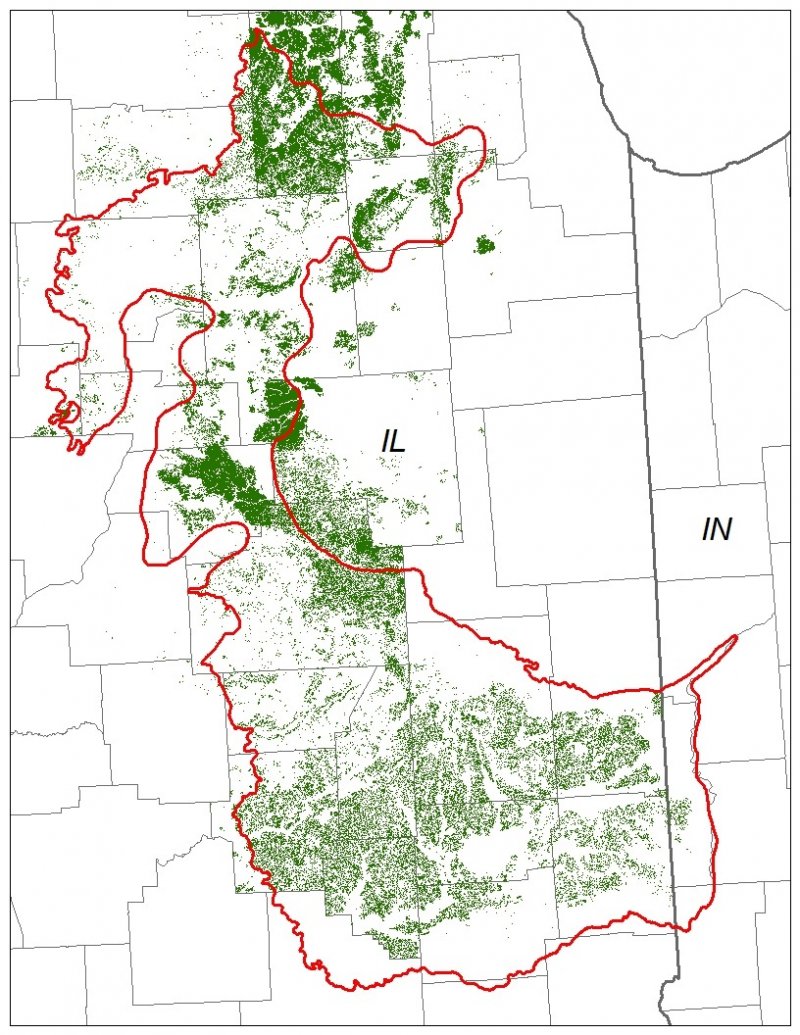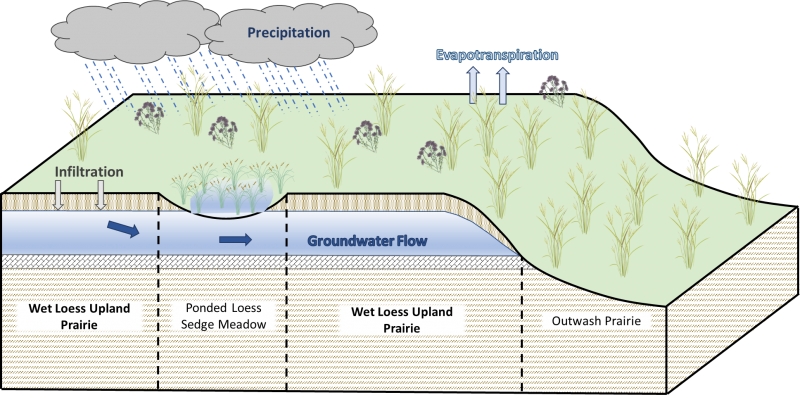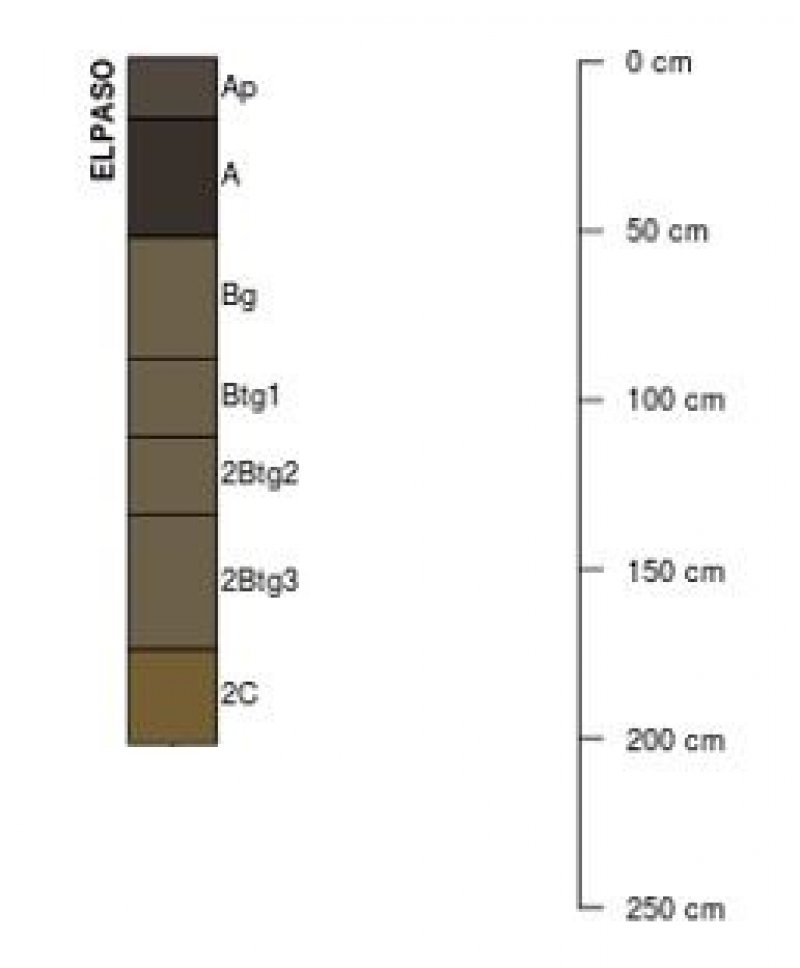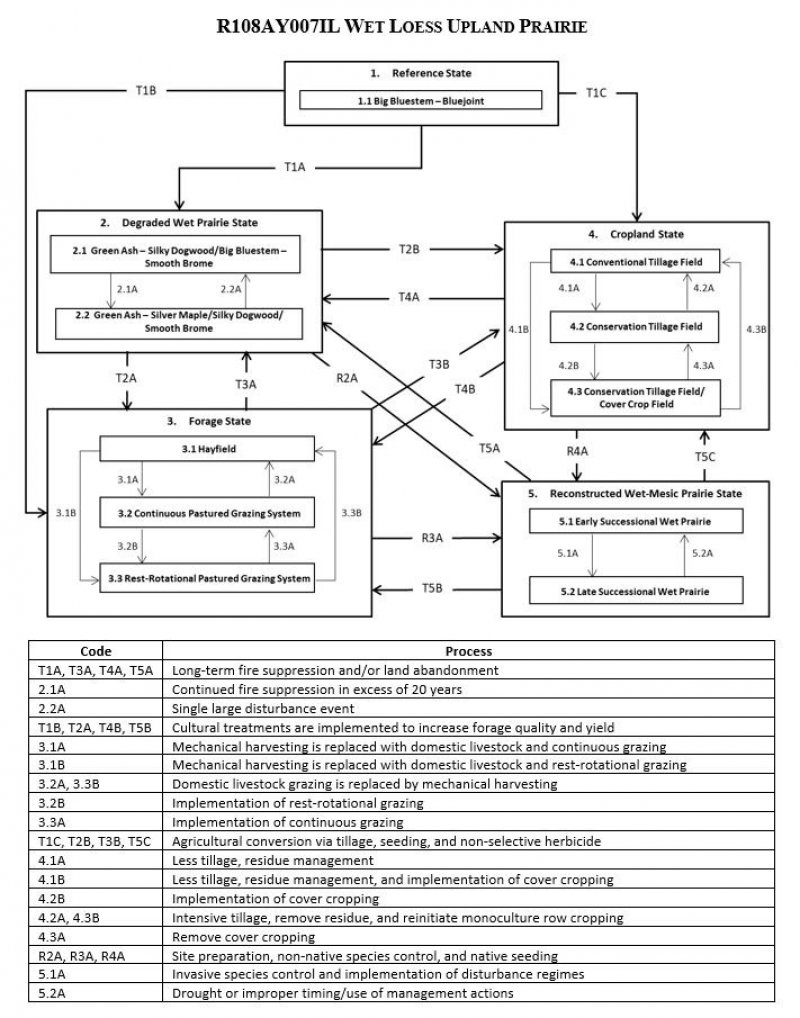Ecological dynamics
The information in this Ecological Site Description, including the state-and-transition model (STM), was developed based on historical data, current field data, professional experience, and a review of the scientific literature. As a result, all possible scenarios or plant species may not be included. Key indicator plant species, disturbances, and ecological processes are described to inform land management decisions.
The MLRA lies within the tallgrass prairie ecosystem of the Midwest. The heterogeneous topography of the area results in variable microclimates and fuel matrices that in turn support prairies, savannas, and forests. Wet Loess Upland Prairies form an aspect of this vegetative continuum. This ecological site occurs on uplands on poorly-drained soils. Species characteristic of this ecological site consist of a mix of upland and hydrophytic herbaceous vegetation.
Fire is a critical disturbance factor that maintains Wet Loess Upland Prairies. Fire intensity typically consisted of periodic, low-intensity surface fires occurring every 2 to 5 years (LANDFIRE 2009). Ignition sources included summertime lightning strikes from convective storms and bimodal, human ignitions during the spring and fall seasons. Native Americans regularly set fires to improve sight lines for hunting, driving large game, improving grazing and browsing habitat, agricultural clearing, and enhancing vital ethnobotanical plants (Barrett 1980).
Drought and grazing by native ungulates have also played a role in shaping this ecological site. The periodic episodes of reduced soil moisture in conjunction with the poorly-drained soils have favored the proliferation of plant species tolerant of such conditions. Drought can also slow the growth of plants and result in dieback of certain species. Large mammals, specifically prairie elk (Cervus elaphus), bison (Bos bison), and white-tailed deer (Odocoileus virginianus), likely occurred in low densities resulting in limited impacts to plant composition and dominance (LANDFIRE 2009). When coupled with fire, periods of drought and herbivory can greatly delay the establishment of woody vegetation (Pyne et al. 1996).
Today, Wet Loess Upland Prairies have been greatly reduced as most areas have been converted to agricultural production. Corn (Zea mays L.) and soybeans (Glycine max (L.) Merr.) are the dominant crops grown, but small patches of forage land may be present. Remnants that do exist show evidence of indirect anthropogenic influences from fire suppression, subsurface drainage, and non-native species invasion. A return to the historic plant community may not be possible following extensive land modification, but long-term conservation agriculture or prairie reconstruction efforts can help to restore some biotic diversity and ecological function. The state-and-transition model that follows provides a detailed description of each state, community phase, pathway, and transition. This model is based on available experimental research, field observations, literature reviews, professional consensus, and interpretations.
State 1
Reference State
The reference plant community is categorized as a wet-mesic tallgrass prairie community, dominated by upland and hydrophytic herbaceous vegetation. The one community phase within the reference state is dependent on periodic fire. The intensity and frequency alter species composition, cover, and extent, while regular fire intervals keep woody species from dominating. Drought and native mammal grazing have more localized impacts in the reference phases, but do contribute to overall species composition, diversity, cover, and productivity.
Community 1.1
Big Bluestem - Bluejoint
Sites in this reference community phase are dominated by a mix of upland and hydrophytic grasses and forbs. Vegetative cover is continuous (95 to 100 percent) and plants can reach heights between 3 and 6 feet tall (NatureServe 2018). Big bluestem, bluejoint, switchgrass, Indiangrass, and prairie cordgrass are the dominant monocots on the site. Characteristic forbs can include meadow evening primrose (Oenothera pilosella Raf.), smooth phlox (Phlox glaberrimaL.), balsam groundsel (Packera paupercula (Michx.) Á. Löve & D. Löve), and golden zizia (Zizia aurea (L.) W.D.J. Koch) (White and Madany 1978). Replacement fires every 2 to 5 years characterize the fire regime, maintaining this reference plant community (NatureServe 2018).
State 2
Fire-Suppressed Scrub State
Long-term fire suppression can transition the reference tallgrass prairie community into a woody-invaded shrub-prairie state. This state is evidenced by a well-developed shrub layer and sparse trees (LANDFIRE 2009). Proximity to lands that have been altered provide opportunities for non-native invasive species to readily colonize this state, thereby reducing the native biodiversity and changing the vegetative community.
Community 2.1
Green Ash - Silky Dogwood/Big Bluestem - Smooth Brome
This community phase represents the early stages of long-term fire-suppression. In as little as six fire-free years, the prairie can be disrupted and succeeded by woody shrubs. Native trees – e.g., green ash (Fraxinus pennsylvanicaMarshall), silver maple (Acer saccharinum L.), elm (Ulmus L.) – and shrubs – e.g. silky dogwood (Cornus obliqua Raf.) – can form dense thickets with cover reaching up to 30 percent and plant heights as tall as 9 feet (LANDFIRE 2009). Some native prairie plants will persist, but non-native herbaceous species, including smooth brome (Bromus inermis Leyss.), Kentucky bluegrass (Poa pratensis L.), and redtop (Agrostis gigantea Roth) can begin to encroach from adjacent, disturbed sites.
Community 2.2
Green Ash - Silver Maple/Silky Dogwood/Smooth Brome
Sites falling into this community phase have a well-established shrub layer, and scattered trees begin to develop in the continued absence of fire and reduced water table.
Pathway 2.1A
Community 2.1 to 2.2
Continued fire suppression in excess of 20 years.
Pathway 2.2A
Community 2.2 to 2.1
Single large disturbance event such as selective removal of some woody species.
State 3
Forage State
The forage state occurs when the reference state is converted to a farming system that emphasizes domestic livestock production known as grassland agriculture. Fire suppression, periodic cultural treatments (e.g., clipping, drainage, soil amendment applications, planting new species and/or cultivars, mechanical harvesting) and grazing by domesticated livestock transition and maintain this state (USDA-NRCS 2003). Early settlers seeded non-native species, such as smooth brome (Bromus inermis Leyss.) and Kentucky bluegrass (Poa pratensis L.), to help extend the grazing season. Over time, as lands were continuously harvested or grazed by herds of cattle, the non-native species were able to spread and expand across the landscape, reducing the native species diversity and ecological function.
Community 3.1
Hayfield
Sites in this community phase consist of forage plants that are planted and mechanically harvested. Mechanical harvesting removes much of the aboveground biomass and nutrients that feed the soil microorganisms (Franzluebbers et al. 2000; USDA-NRCS 2003). As a result, soil biology is reduced leading to decreases in nutrient uptake by plants, soil organic matter, and soil aggregation. Frequent biomass removal can also reduce the site's carbon sequestration capacity (Skinner 2008).
Community 3.2
Continuous Pastured Grazing System
This community phase is characterized by continuous grazing where domestic livestock graze a pasture for the entire season. Depending on stocking density, this can result in lower forage quality and productivity, weed invasions, and uneven pasture use. Continuous grazing can also increase the amount of bare ground and erosion and reduce soil organic matter, cation exchange capacity, water-holding capacity, and nutrient availability and retention (Bharati et al. 2002; Leake et al. 2004; Teague et al. 2011). Smooth brome, Kentucky bluegrass, and white clover (Trifolium repens L.) are common pasture species used in this phase. Their tolerance to continuous grazing has allowed these species to dominate, sometimes completely excluding the native vegetation.
Community 3.3
Rest-Rotation Pastured Grazing System
This community phase is characterized by rotational grazing where the pasture has been subdivided into several smaller paddocks. Through the development of a grazing plan, livestock utilize one or a few paddocks, while the remaining area is rested allowing plants to restore vigor and energy reserves, deepen root systems, develop seeds, as well as allow seedling establishment (Undersander et al. 2002; USDA-NRCS 2003). Rest-rotation pastured grazing systems include deferred rotation, rest rotation, high intensity – low frequency, and short duration methods. Vegetation is generally more diverse and can include orchardgrass (Dactylis glomerata L.), timothy (Phleum pretense L.), red clover (Trifolium pratense L.), and alfalfa (Medicago sativa L.). The addition of native prairie species can further bolster plant diversity and, in turn, soil function. This community phase promotes numerous ecosystem benefits including increasing biodiversity, preventing soil erosion, maintaining and enhancing soil quality, sequestering atmospheric carbon, and improving water yield and quality (USDA-NRCS 2003).
Pathway 3.1A
Community 3.1 to 3.2
Mechanical harvesting is replaced with domestic livestock utilizing continuous grazing.
Pathway 3.1B
Community 3.1 to 3.3
Mechanical harvesting is replaced with domestic livestock utilizing rotational grazing.
Pathway 3.2A
Community 3.2 to 3.1
Domestic livestock are removed, and mechanical harvesting is implemented.
Pathway 3.2B
Community 3.2 to 3.3
Rotational grazing replaces continuous grazing.
Pathway 3.3B
Community 3.3 to 3.1
Domestic livestock are removed, and mechanical harvesting is implemented.
Pathway 3.3A
Community 3.3 to 3.2
Continuous grazing replaces rotational grazing.
State 4
Cropland State
The continuous use of tillage, row-crop planting, and chemicals (i.e., herbicides, fertilizers, etc.) and subsurface tile drainage have effectively eliminated the reference community and many of its natural ecological functions in favor of crop production. Corn and soybeans are the dominant crops for the site, and oats (Avena L.) and alfalfa (Medicago sativa L.) may be rotated periodically. These areas are likely to remain in crop production for the foreseeable future.
Community 4.1
Conventional Tillage Field
Sites in this community phase typically consist of monoculture row-cropping maintained by conventional tillage practices. They are cropped in either continuous corn or corn-soybean rotations. The frequent use of deep tillage, low crop diversity, and bare soil conditions during the non-growing season negatively impacts soil health. Under these practices, soil aggregation is reduced or destroyed, soil organic matter is reduced, erosion and runoff are increased, and infiltration is decreased, which can ultimately lead to undesirable changes in the hydrology of the watershed (Tomer et al. 2005).
Community 4.2
Conservation Tillage Field
This community phase is characterized by rotational crop production that utilizes various conservation tillage methods to promote soil health and reduce erosion. Conservation tillage methods include strip-till, ridge-till, vertical-till, or no-till planting systems. Strip-till keeps seedbed preparation to narrow bands less than one-third the width of the row where crop residue and soil consolidation are left undisturbed in-between seedbed areas. Strip-till planting may be completed in the fall and nutrient application either occurs simultaneously or at the time of planting. Ridge-till uses specialized equipment to create ridges in the seedbed and vegetative residue is left on the surface in between the ridges. Weeds are controlled with herbicides and/or cultivation, seedbed ridges are rebuilt during cultivation, and soils are left undisturbed from harvest to planting. Vertical-till systems employ machinery that lightly tills the soil and cuts up crop residue, mixing some of the residue into the top few inches of the soil while leaving a large portion on the surface. No-till management is the most conservative, disturbing soils only at the time of planting and fertilizer application. Compared to conventional tillage systems, conservation tillage methods can improve soil ecosystem function by reducing soil erosion, increasing organic matter and water availability, improving water quality, and reducing soil compaction.
Community 4.3
Conservation Tillage Field/Alternative Crop Field
This community phase applies conservation tillage methods as described above as well as adds cover crop practices. Cover crops typically include nitrogen-fixing species (e.g., legumes), small grains (e.g., rye, wheat, oats), or forage covers (e.g., turnips, radishes, rapeseed). The addition of cover crops not only adds plant diversity but also promotes soil health by reducing soil erosion, limiting nitrogen leaching, suppressing weeds, increasing soil organic matter, and improving the overall soil ecosystem. In the case of small grain cover crops, surface cover and water infiltration are increased, while forage covers can be used to graze livestock or support local wildlife. Of the three community phases for this state, this phase promotes the greatest soil sustainability and improves ecological functioning within a cropland system.
Pathway 4.1A
Community 4.1 to 4.2
Tillage operations are greatly reduced, crop rotation occurs on a regular interval, and crop residue remains on the soil surface.
Pathway 4.1B
Community 4.1 to 4.3
Tillage operations are greatly reduced or eliminated, crop rotation occurs on a regular interval, crop residue remains on the soil surface, and cover crops are planted following crop harvest.
Pathway 4.2A
Community 4.2 to 4.1
Intensive tillage is utilized, and monoculture row-cropping is established.
Pathway 4.2B
Community 4.2 to 4.3
Cover crops are implemented to minimize soil erosion.
Pathway 4.3B
Community 4.3 to 4.1
Intensive tillage is utilized, cover crop practices are abandoned, monoculture row-cropping is established, and crop rotation is reduced or eliminated.
Pathway 4.3A
Community 4.3 to 4.2
Cover crop practices are abandoned.
State 5
Reconstructed Wet-Mesic Prairie State
Prairie reconstructions have become an important tool for repairing natural ecological functions and conserving biodiversity. Because the historic plant and soil biota communities of the tallgrass prairie were highly diverse with complex interrelationships, historic prairie replication cannot be guaranteed on landscapes that have been so extensively manipulated for extended timeframes (Kardol and Wardle 2010; Fierer et al. 2013). Therefore, ecological restoration should aim to aid the recovery of degraded, damaged, or destroyed ecosystems. A successful restoration will have the ability to structurally and functionally sustain itself, demonstrate resilience to the natural ranges of stress and disturbance, and create and maintain positive biotic and abiotic interactions (SER 2002). The reconstructed wet-mesic prairie state is the result of a long-term commitment involving a multi-step, adaptive management process. Diverse, species-rich seed mixes are important to utilize as they allow the site to undergo successional stages that exhibit changing composition and dominance over time (Smith et al. 2010). On-going management via prescribed fire and/or light grazing can help the site progress from an early successional community dominated by annuals and some weeds to a later seral stage composed of native, perennial grasses, forbs, and a few shrubs. Establishing a prescribed fire regimen that mimics natural disturbance patterns can increase native species cover and diversity while reducing cover of non-native forbs and grasses. Light grazing alone can help promote species richness, while grazing accompanied with fire can control the encroachment of woody vegetation (Brudvig et al. 2007).
Community 5.1
Early Successional Reconstructed Wet-Mesic Prairie
This community phase represents the early community assembly from prairie reconstruction and is highly dependent on hydroperiod repair, a diverse seed mix, and the timing and priority of planting operations. The seed mix should look to include a diverse mix of cool-season and warm-season annual and perennial grasses and forbs typical of the reference state (e.g., big bluestem, switchgrass, prairie cordgrass, New England aster). Cool-season annuals can help provide litter that promotes cool, moist soil conditions to the benefit of the other species in the seed mix. The first season following site preparation and seeding will typically result in annuals and other volunteer species forming a majority of vegetative cover. Control of non-native species, particularly perennial species, is crucial at this point to ensure they do not establish before the native vegetation (Martin and Wilsey 2012). After the first season, native warm-season grasses should begin to become more prominent on the landscape.
Community 5.2
Late Successional Reconstructed Wet-Mesic Prairie
Appropriately timed disturbance regimes (e.g., prescribed fire) applied to the early successional community phase can help increase the beta diversity, pushing the site into a late successional community phase over time. While prairie communities are dominated by grasses, these species can suppress forb establishment and reduce overall diversity and ecological function (Martin and Wilsey 2006; Williams et al. 2007). Reducing accumulated plant litter from perennial bunchgrasses allows more light and nutrients to become available for forb recruitment, allowing greater ecosystem complexity (Wilsey 2008).
Pathway 5.1A
Community 5.1 to 5.2
Selective herbicides are used to control non-native species, and prescribed fire and/or light grazing helps to increase the native species diversity and control woody vegetation.
Pathway 5.2A
Community 5.2 to 5.1
Reconstruction experiences a decrease in native species diversity from drought or improper timing of management actions (e.g., reduced fire frequency, use of non-selective herbicides).
Transition T1A
State 1 to 2
Long-term fire suppression transition the site to the fire-suppressed scrub state (2).
Transition T1B
State 1 to 3
Cultural treatments to enhance forage quality and yield transitions the site to the forage state (3).
Transition T1C
State 1 to 4
Tillage, seeding of agricultural crops, and non-selective herbicide transition the site to the cropland state (4).
Transition T2A
State 2 to 3
Cultural treatments to enhance forage quality and yield transitions the site to the forage state (3).
Transition T2B
State 2 to 4
Tillage, seeding of agricultural crops, and non-selective herbicide transition this site to the cropland state (4).
Restoration pathway R2A
State 2 to 5
Site preparation, invasive species control, and seeding native species transition this site to the reconstructed wet-mesic prairie state (5).
Transition T3A
State 3 to 2
Land abandonment transitions the site to the fire-suppressed state (2).
Transition T3B
State 3 to 4
Tillage, seeding of agricultural crops, and non-selective herbicide transition this site to the cropland state (4).
Restoration pathway R3A
State 3 to 5
Site preparation, invasive species control, and seeding native species transition this site to the reconstructed wet-mesic prairie state (5).
Transition T4A
State 4 to 2
Land abandonment transitions the site to the fire-suppressed scrub state (2).
Transition T4B
State 4 to 3
Cultural treatments to enhance forage quality and yield transitions the site to the forage state (3).
Restoration pathway R4A
State 4 to 5
Site preparation, invasive species control, and seeding native species transition this site to the reconstructed wet-mesic prairie state (5).
Transition T5A
State 5 to 2
Land abandonment transitions the site to the fire-suppressed scrub state (2).
Transition T5B
State 5 to 3
Cultural treatments to enhance forage quality and yield transition the site to the forage state (3).
Transition T5C
State 5 to 4
Tillage, seeding of agricultural crops, and non-selective herbicide transition this site to the cropland state (4).




